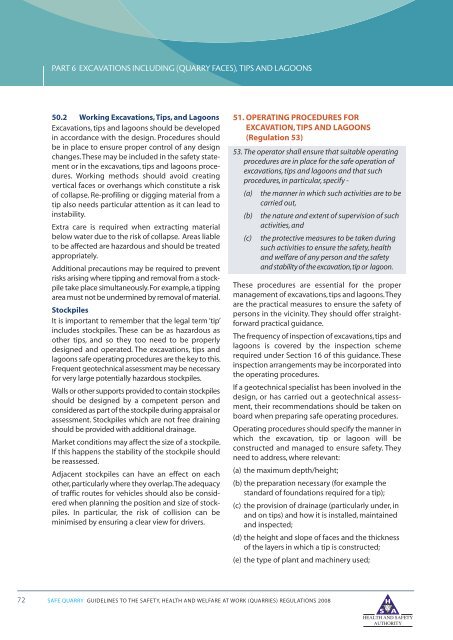Safe Quarry - Health and Safety Authority
Safe Quarry - Health and Safety Authority
Safe Quarry - Health and Safety Authority
You also want an ePaper? Increase the reach of your titles
YUMPU automatically turns print PDFs into web optimized ePapers that Google loves.
PART 6 EXCAVATIONS INCLUDING (QUARRY FACES), TIPS AND LAGOONS<br />
50.2 Working Excavations, Tips, <strong>and</strong> Lagoons<br />
Excavations, tips <strong>and</strong> lagoons should be developed<br />
in accordance with the design. Procedures should<br />
be in place to ensure proper control of any design<br />
changes.These may be included in the safety statement<br />
or in the excavations, tips <strong>and</strong> lagoons procedures.<br />
Working methods should avoid creating<br />
vertical faces or overhangs which constitute a risk<br />
of collapse. Re-profiling or digging material from a<br />
tip also needs particular attention as it can lead to<br />
instability.<br />
Extra care is required when extracting material<br />
below water due to the risk of collapse. Areas liable<br />
to be affected are hazardous <strong>and</strong> should be treated<br />
appropriately.<br />
Additional precautions may be required to prevent<br />
risks arising where tipping <strong>and</strong> removal from a stockpile<br />
take place simultaneously.For example,a tipping<br />
area must not be undermined by removal of material.<br />
Stockpiles<br />
It is important to remember that the legal term ‘tip’<br />
includes stockpiles. These can be as hazardous as<br />
other tips, <strong>and</strong> so they too need to be properly<br />
designed <strong>and</strong> operated. The excavations, tips <strong>and</strong><br />
lagoons safe operating procedures are the key to this.<br />
Frequent geotechnical assessment may be necessary<br />
for very large potentially hazardous stockpiles.<br />
Walls or other supports provided to contain stockpiles<br />
should be designed by a competent person <strong>and</strong><br />
considered as part of the stockpile during appraisal or<br />
assessment. Stockpiles which are not free draining<br />
should be provided with additional drainage.<br />
Market conditions may affect the size of a stockpile.<br />
If this happens the stability of the stockpile should<br />
be reassessed.<br />
Adjacent stockpiles can have an effect on each<br />
other,particularly where they overlap.The adequacy<br />
of traffic routes for vehicles should also be considered<br />
when planning the position <strong>and</strong> size of stockpiles.<br />
In particular, the risk of collision can be<br />
minimised by ensuring a clear view for drivers.<br />
51. OPERATING PROCEDURES FOR<br />
EXCAVATION, TIPS AND LAGOONS<br />
(Regulation 53)<br />
53. The operator shall ensure that suitable operating<br />
procedures are in place for the safe operation of<br />
excavations, tips <strong>and</strong> lagoons <strong>and</strong> that such<br />
procedures, in particular, specify -<br />
(a) the manner in which such activities are to be<br />
carried out,<br />
(b) the nature <strong>and</strong> extent of supervision of such<br />
activities, <strong>and</strong><br />
(c) the protective measures to be taken during<br />
such activities to ensure the safety, health<br />
<strong>and</strong> welfare of any person <strong>and</strong> the safety<br />
<strong>and</strong> stability of the excavation,tip or lagoon.<br />
These procedures are essential for the proper<br />
management of excavations, tips <strong>and</strong> lagoons.They<br />
are the practical measures to ensure the safety of<br />
persons in the vicinity. They should offer straightforward<br />
practical guidance.<br />
The frequency of inspection of excavations, tips <strong>and</strong><br />
lagoons is covered by the inspection scheme<br />
required under Section 16 of this guidance. These<br />
inspection arrangements may be incorporated into<br />
the operating procedures.<br />
If a geotechnical specialist has been involved in the<br />
design, or has carried out a geotechnical assessment,<br />
their recommendations should be taken on<br />
board when preparing safe operating procedures.<br />
Operating procedures should specify the manner in<br />
which the excavation, tip or lagoon will be<br />
constructed <strong>and</strong> managed to ensure safety. They<br />
need to address, where relevant:<br />
(a) the maximum depth/height;<br />
(b) the preparation necessary (for example the<br />
st<strong>and</strong>ard of foundations required for a tip);<br />
(c) the provision of drainage (particularly under, in<br />
<strong>and</strong> on tips) <strong>and</strong> how it is installed, maintained<br />
<strong>and</strong> inspected;<br />
(d) the height <strong>and</strong> slope of faces <strong>and</strong> the thickness<br />
of the layers in which a tip is constructed;<br />
(e) the type of plant <strong>and</strong> machinery used;<br />
72<br />
SAFE QUARRY GUIDELINES TO THE SAFETY, HEALTH AND WELFARE AT WORK (QUARRIES) REGULATIONS 2008
















